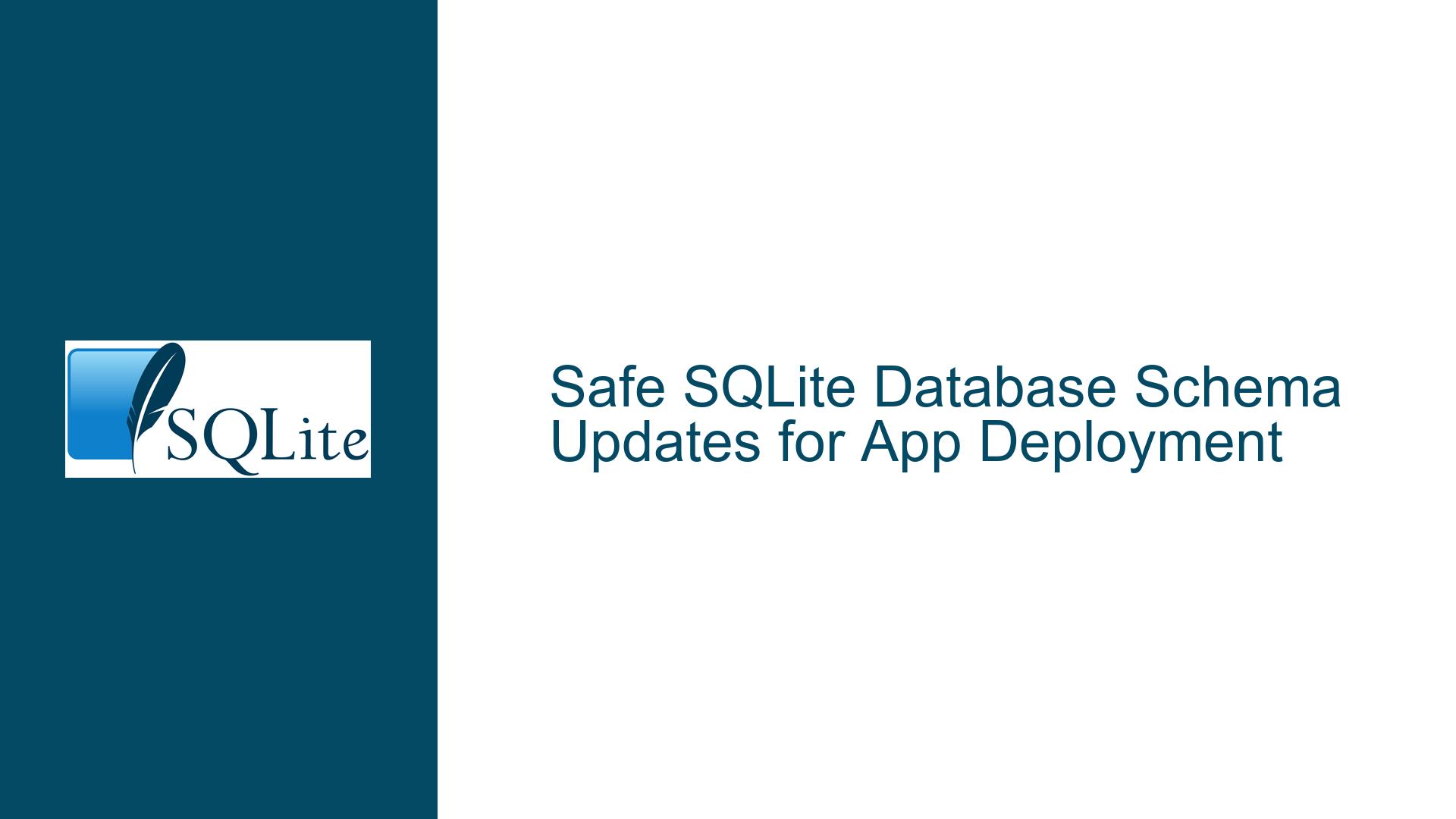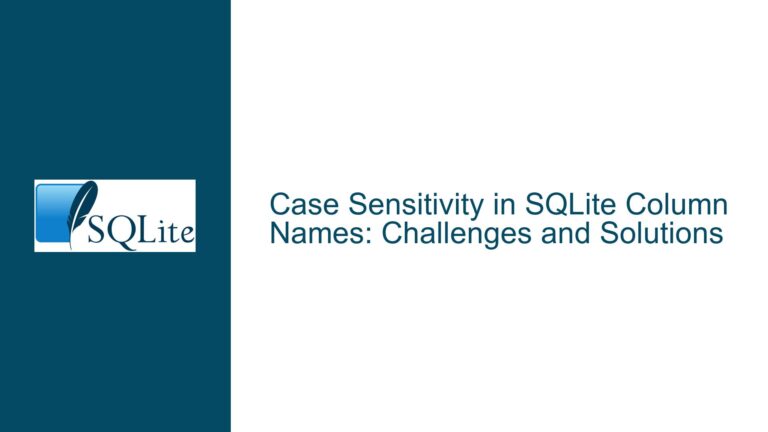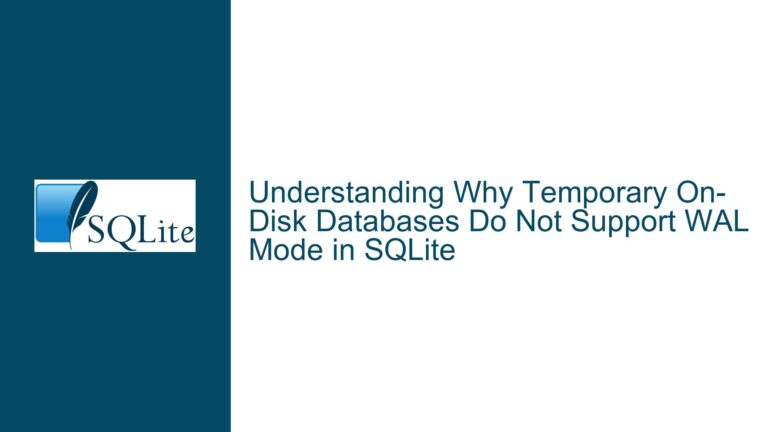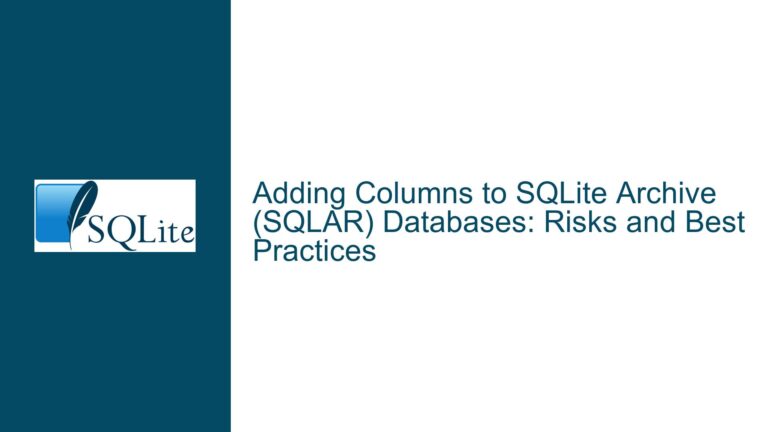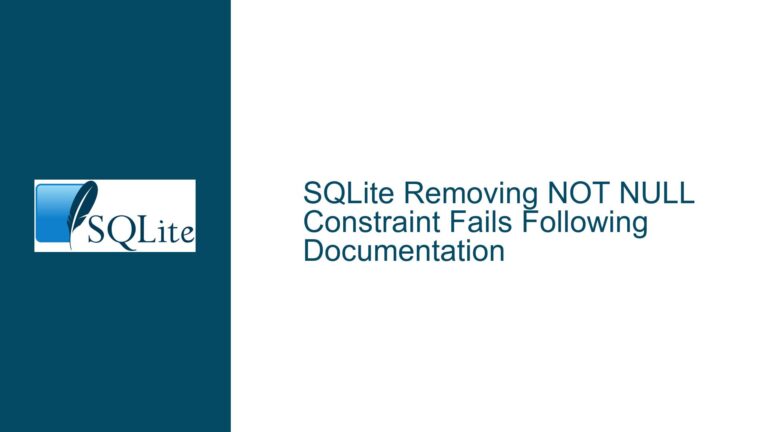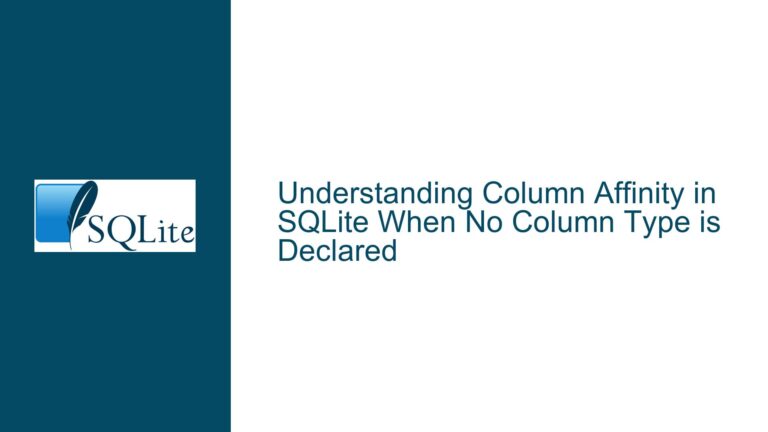Safe SQLite Database Schema Updates for App Deployment
Understanding the Need for Safe Schema Updates in SQLite
When developing applications that rely on SQLite databases, one of the most critical challenges is managing schema updates across different versions of the app. Unlike server-based databases where schema changes can be managed centrally, SQLite databases are often distributed with the application, making schema updates a more complex task. The primary concern is ensuring that the database structure evolves seamlessly as the application updates, without causing data loss or corruption. This is particularly important when users may skip updates or when multiple versions of the app are in use simultaneously.
The core issue revolves around how to safely and efficiently update the SQLite database schema when deploying new versions of an application. The goal is to ensure that the database structure aligns with the application’s expectations, regardless of whether the user is upgrading from an older version or installing the app for the first time. This requires a robust strategy that can handle schema migrations, version tracking, and potential rollbacks without compromising data integrity.
Exploring the Challenges of Schema Versioning and Migration
One of the main challenges in managing SQLite schema updates is the lack of built-in support for schema versioning and migration. Unlike some other database systems, SQLite does not provide a native mechanism for tracking schema versions or automatically applying migrations. This means that developers must implement their own versioning and migration strategies, which can vary significantly depending on the application’s requirements.
Another challenge is ensuring backward and forward compatibility. When an application is updated, the new version must be able to work with databases created by older versions, and vice versa. This requires careful planning and testing to ensure that schema changes do not break existing functionality or cause data inconsistencies. Additionally, the migration process must be designed to handle cases where users skip updates or roll back to previous versions of the app.
The complexity of schema changes also plays a role in determining the best approach. Simple changes, such as adding a new column, can often be handled using SQLite’s ALTER TABLE command. However, more complex changes, such as renaming columns or changing data types, may require a more involved process, such as creating a new table, copying data, and dropping the old table. This can introduce additional risks, such as data loss or corruption, if not done correctly.
Implementing a Robust Schema Update Strategy
To address these challenges, a robust schema update strategy should be implemented, focusing on version tracking, migration scripts, and compatibility. The following sections will delve into the details of each component, providing a comprehensive guide to safely updating SQLite database schemas in an application.
Version Tracking with user_version Pragma
One of the most effective ways to manage schema updates in SQLite is by using the user_version pragma. This pragma allows developers to store a version number directly in the database file, which can be used to track the current schema version. By incrementing this version number with each schema change, the application can determine which migrations need to be applied when it starts up.
The user_version pragma is a simple yet powerful tool for version tracking. It is a 32-bit integer that can be set and retrieved using the PRAGMA user_version command. When the application starts, it can check the current value of user_version and compare it to the expected version. If the database version is lower than the expected version, the application can apply the necessary migrations to bring the database up to date.
For example, consider an application that starts with a database schema version of 0. When the first schema change is introduced, the version is incremented to 1, and a migration script is created to transform the database from version 0 to 1. The application checks the user_version pragma on startup and applies the migration if the version is less than 1. This process is repeated for each subsequent schema change, ensuring that the database is always up to date with the application’s requirements.
Designing Migration Scripts for Schema Changes
Migration scripts are the heart of any schema update strategy. These scripts contain the SQL commands necessary to transform the database from one version to the next. When designing migration scripts, it is important to consider the complexity of the changes and the potential impact on existing data.
For simple changes, such as adding a new column, the ALTER TABLE command can be used. However, SQLite’s ALTER TABLE command has limitations, and more complex changes may require a different approach. In such cases, the recommended method is to create a new table with the desired structure, copy the data from the old table to the new table, and then drop the old table. This process is often referred to as the "create-new-table-and-copy" method.
For example, consider a scenario where a column needs to be renamed. SQLite does not support renaming columns directly, so the following steps would be necessary:
- Create a new table with the desired column names and structure.
- Copy the data from the old table to the new table.
- Drop the old table.
- Rename the new table to the original table name.
This method ensures that the data is preserved while allowing for the necessary schema changes. However, it is important to handle this process carefully to avoid data loss or corruption. For instance, if the new table has a different structure, the data copying process must account for any differences in column types or constraints.
Handling Multiple Versions and Rollbacks
In some cases, an application may need to support multiple versions of the database schema simultaneously. This can occur when different users are running different versions of the app, or when a user rolls back to a previous version. To handle this scenario, the schema update strategy must be designed to be both backward and forward compatible.
One approach is to split the user_version value into two parts: a major version and a minor version. The major version represents significant changes to the schema, while the minor version represents smaller, incremental changes. For example, a major version could be represented by the upper 16 bits of the user_version value, and the minor version by the lower 16 bits. This allows for up to 65,535 minor versions per major version, providing ample room for schema evolution.
When the application starts, it can check both the major and minor versions of the database and apply the necessary migrations accordingly. If the major version matches the expected version, the application can apply the minor version migrations. If the major version is different, the application may need to handle more significant changes, such as creating new tables or dropping old ones.
Rollbacks can be handled in a similar manner. If a user rolls back to a previous version of the app, the application can check the user_version pragma and apply any necessary downgrade migrations. However, as noted by Warren Young, downgrade code is often unnecessary and can be avoided in most cases. Instead, the focus should be on ensuring that the database remains compatible with the current version of the app, while allowing for the possibility of manual schema changes or restorations from backup if needed.
Using Tools like Sqitch for Schema Management
While implementing a custom schema update strategy can be effective, it can also be time-consuming and error-prone. For developers looking for a more streamlined approach, tools like Sqitch can be a valuable resource. Sqitch is a database change management tool that automates the process of applying and tracking schema changes.
Sqitch works by organizing schema changes into a series of "changesets," each of which contains the SQL commands necessary to apply a specific change. These changesets are stored in a version-controlled directory, allowing developers to track and manage schema changes alongside their application code. When the application starts, Sqitch can be used to apply any pending changesets, ensuring that the database is always up to date.
One of the key benefits of Sqitch is its support for multiple database systems, including SQLite. This makes it a versatile tool for developers working with different databases or migrating between them. Additionally, Sqitch provides features such as dependency management, which ensures that changesets are applied in the correct order, and verification, which checks that the changes have been applied successfully.
While Sqitch can simplify the schema update process, it is important to note that it is not a silver bullet. Developers must still carefully design their schema changes and test them thoroughly to ensure compatibility and data integrity. However, for teams looking to automate and standardize their schema management process, Sqitch can be a valuable tool.
Best Practices for Safe Schema Updates
To ensure a smooth and safe schema update process, developers should follow a set of best practices when designing and implementing their schema update strategy. These practices include:
Version Control for Schema Changes: Just as application code is version-controlled, schema changes should also be tracked using a version control system. This allows developers to review, revert, and collaborate on schema changes, ensuring that the database evolves in a controlled and predictable manner.
Automated Testing: Schema changes should be tested thoroughly before being deployed to production. This includes testing the migration scripts, verifying data integrity, and ensuring that the application functions correctly with the updated schema. Automated testing can help catch issues early and reduce the risk of data loss or corruption.
Backup and Restore Procedures: Before applying any schema changes, it is essential to back up the existing database. This provides a safety net in case something goes wrong during the migration process. Additionally, having a well-defined restore procedure can help minimize downtime and data loss in the event of a failure.
Documentation and Communication: Schema changes should be documented clearly, including the rationale for the change, the steps involved, and any potential impact on the application or data. This documentation should be shared with the development team and other stakeholders to ensure that everyone is aware of the changes and their implications.
Incremental and Reversible Changes: Whenever possible, schema changes should be designed to be incremental and reversible. This means breaking down complex changes into smaller, manageable steps and ensuring that each step can be rolled back if necessary. This approach reduces the risk of introducing errors and makes it easier to troubleshoot issues if they arise.
Monitoring and Logging: During the migration process, it is important to monitor the database and application for any signs of issues. This includes logging the progress of the migration, tracking any errors or warnings, and verifying that the data remains consistent throughout the process. Monitoring and logging can help identify and resolve issues quickly, minimizing the impact on users.
User Communication: If the schema changes require user action, such as upgrading the app or running a specific command, it is important to communicate this clearly to users. Providing clear instructions and support can help ensure that users complete the necessary steps and avoid potential issues.
Conclusion
Updating the SQLite database schema in an application is a complex but essential task that requires careful planning and execution. By implementing a robust schema update strategy that includes version tracking, migration scripts, and compatibility considerations, developers can ensure that their databases evolve seamlessly with their applications. Tools like Sqitch can further streamline the process, but the key to success lies in following best practices, testing thoroughly, and maintaining clear communication with the development team and users.
With the right approach, developers can confidently manage schema updates, ensuring that their applications remain reliable, performant, and scalable as they grow and evolve. Whether you are working on a small project or a large-scale application, the principles outlined in this guide will help you navigate the challenges of SQLite schema updates and keep your database in sync with your application’s needs.
